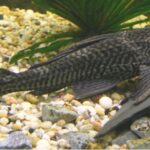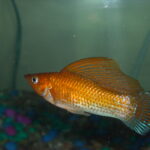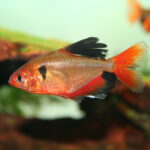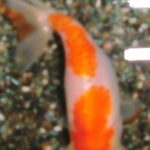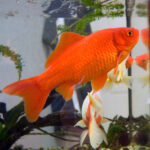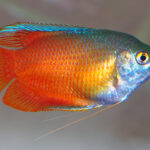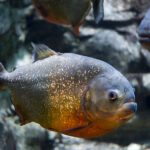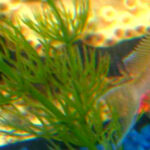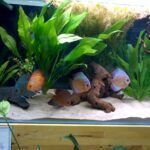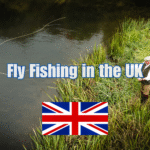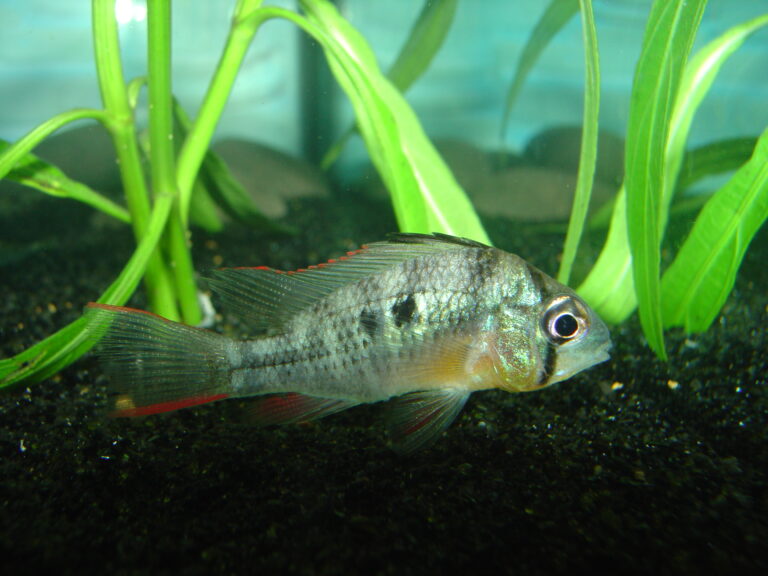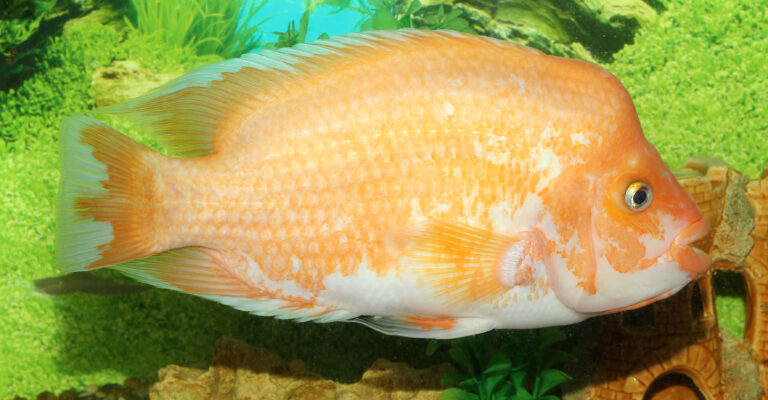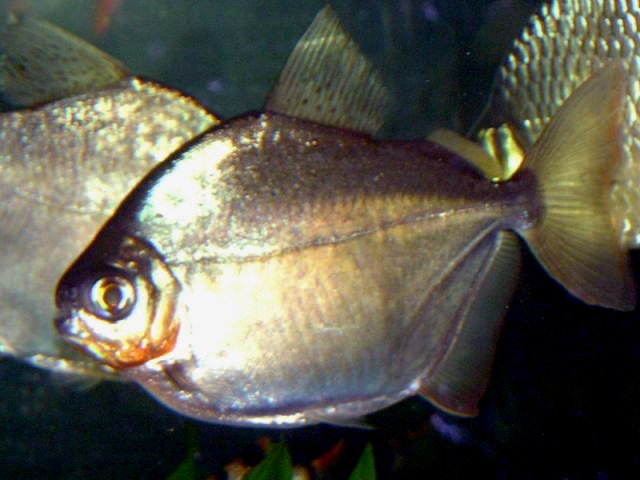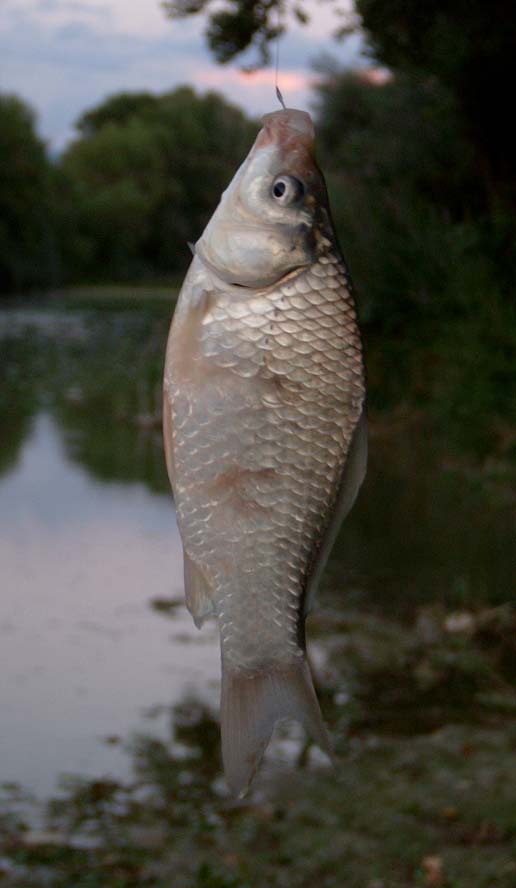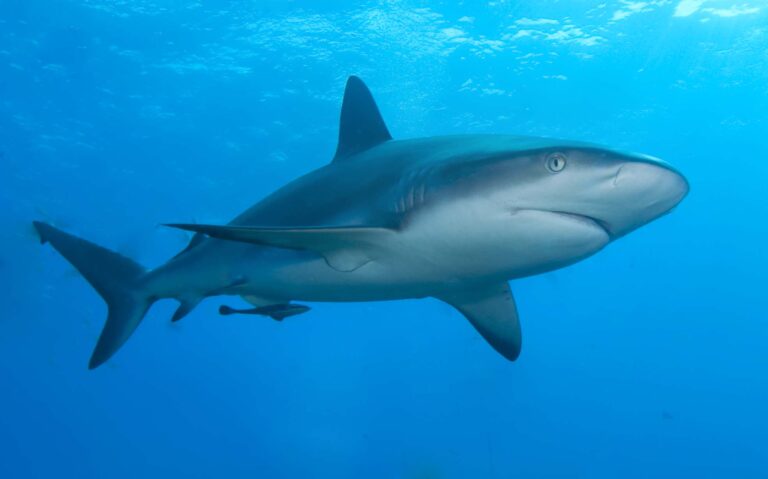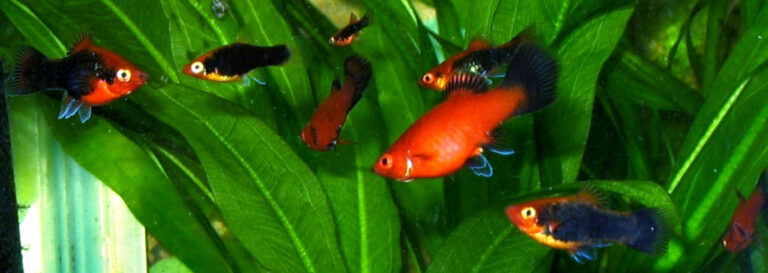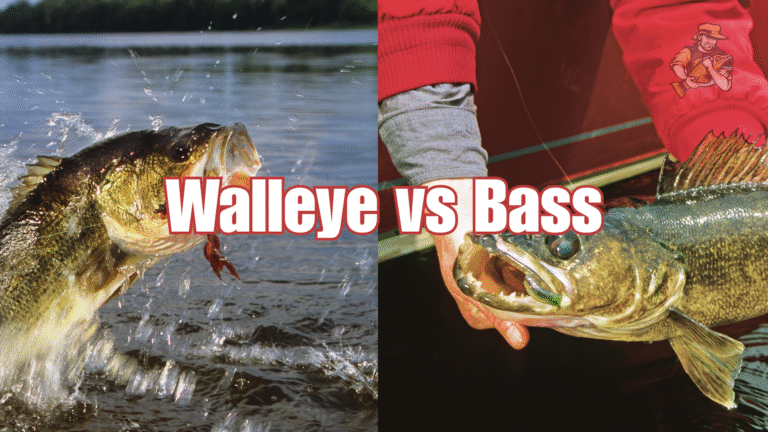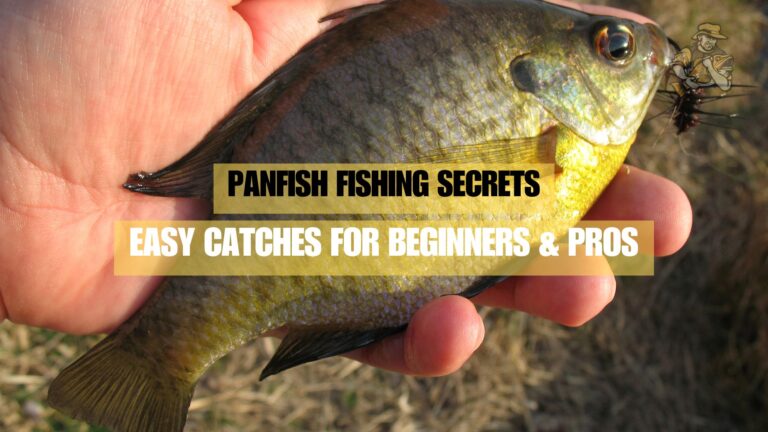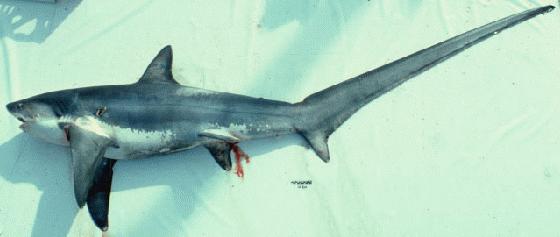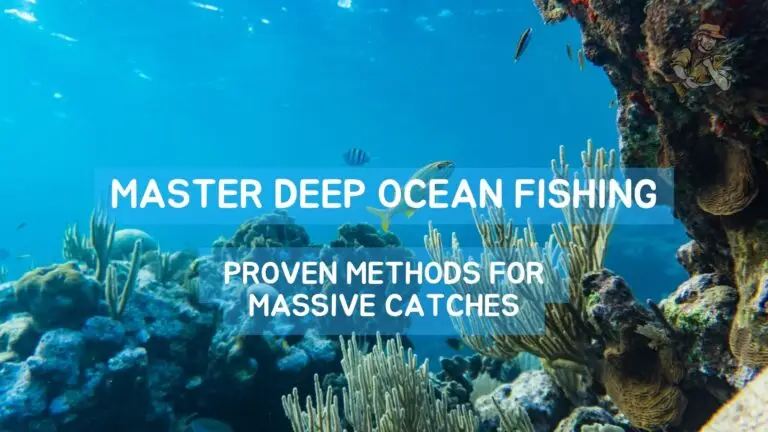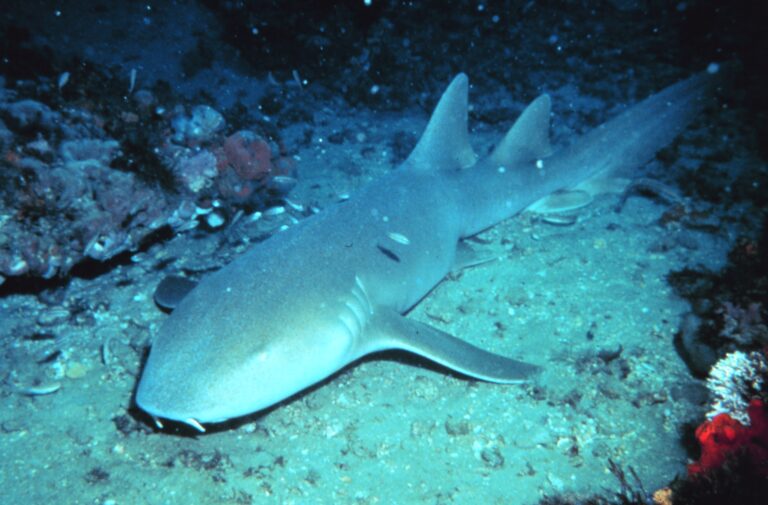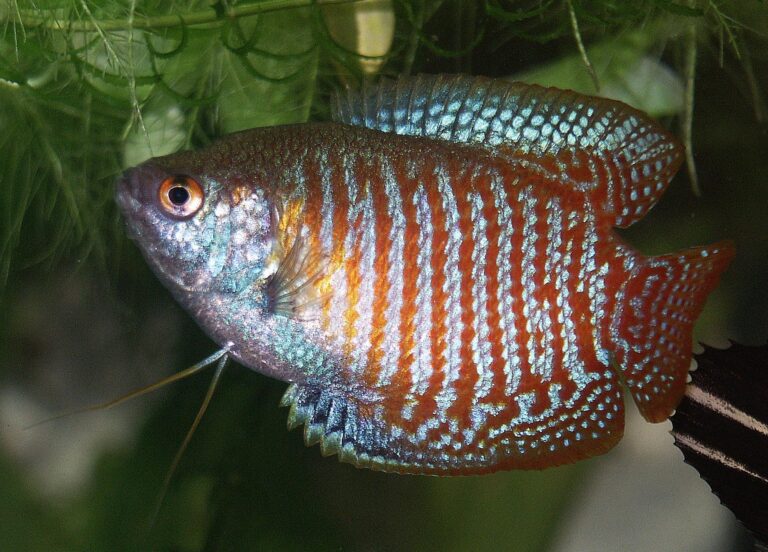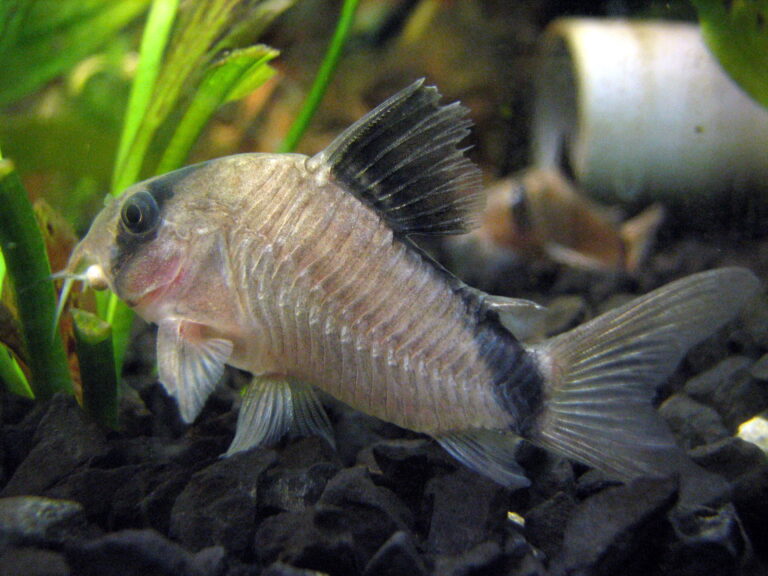Blood Parrot Cichlid
By Ryan Maron | Last Modified: June 9, 2025

The Blood Parrot Cichlid stands as one of the most distinctive and controversial specimens in contemporary aquarium culture. This hybrid fish, scientifically known as *Amphilophus citrinellus* x *Vieja synspilus*, represents a unique artificial creation that has sparked considerable debate within the aquatic community. Unlike naturally occurring species, the Blood Parrot Cichlid emerged through selective breeding practices that combined characteristics from multiple Central American cichlid species.
The significance of the Blood Parrot Cichlid extends beyond its ornamental appeal, serving as a compelling case study in artificial selection and hybrid vigor while simultaneously raising important questions about ethical breeding practices. These fish have established themselves as popular aquarium specimens due to their vibrant coloration, distinctive body shape, and relatively peaceful temperament compared to their parent species. Despite their artificial origins, Blood Parrot Cichlids have demonstrated remarkable adaptability and longevity in captive environments, contributing to their widespread distribution in the global aquarium trade.
Within aquarium ecosystems, Blood Parrot Cichlids function as mid-level inhabitants that help maintain ecological balance through their omnivorous feeding habits and territorial behaviors. Their presence influences the dynamics of tank communities, often serving as focal species around which aquarists design their aquatic landscapes.
| Feature | Details |
|---|---|
| Common Name | Blood Parrot Cichlid |
| Scientific Name | Amphilophus citrinellus x Vieja synspilus |
| Family | Cichlidae |
| Typical Size | 15-20 cm (6-8 inches), 200-400g |
| Habitat | Aquarium-only (artificial hybrid) |
| Diet | Omnivorous |
| Distribution | Global aquarium trade |
| Conservation Status | Not Applicable (Hybrid Species) |
Taxonomy & Classification
The taxonomic classification of the Blood Parrot Cichlid presents unique challenges due to its hybrid nature. Unlike naturally occurring species that follow traditional binomial nomenclature, the Blood Parrot Cichlid represents an artificial cross between *Amphilophus citrinellus* (Midas cichlid) and *Vieja synspilus* (Redhead cichlid), both members of the family Cichlidae. This hybridization occurred through selective breeding programs initiated in Taiwan during the 1980s, making the Blood Parrot Cichlid a relatively recent addition to the aquarium trade.
The family Cichlidae encompasses over 2,000 species distributed across tropical and subtropical regions worldwide, with the highest diversity concentrated in Africa’s Great Lakes and Central America. Blood Parrot Cichlids inherit characteristics from both parent lineages, combining the robust body structure of *Vieja synspilus* with the vibrant coloration potential of *Amphilophus citrinellus*. This genetic combination results in fish that exhibit hybrid vigor while maintaining the territorial and social behaviors characteristic of cichlids.
Modern genetic analysis has confirmed the hybrid status of Blood Parrot Cichlids through DNA sequencing techniques. These studies reveal the complex genetic makeup that contributes to their distinctive phenotype, including the characteristic compressed body shape and modified mouth structure. The hybridization process involved multiple generations of selective breeding to stabilize desired traits while minimizing fertility issues commonly associated with interspecific crosses.
Within the broader context of cichlid classification, Blood Parrot Cichlids represent a significant departure from natural evolutionary processes. Their existence highlights the impact of human intervention in fish breeding and raises important questions about the boundaries between natural and artificial species classifications in taxonomic systems.
Physical Description
The Blood Parrot Cichlid displays a highly distinctive physical appearance that immediately distinguishes it from both parent species and other cichlids. The most prominent feature is the characteristic rounded, laterally compressed body shape that creates an almost heart-shaped profile when viewed from the side. This unique morphology results from the hybridization process and selective breeding for specific aesthetic traits that appeal to aquarium enthusiasts.
Coloration represents the most striking aspect of Blood Parrot Cichlid appearance, with the majority of specimens exhibiting vibrant orange to red hues that inspired their common name. Color intensity varies significantly among individuals, ranging from pale orange to deep crimson red, with some specimens displaying yellow, purple, or even parti-colored patterns. The intensity of coloration can fluctuate based on environmental factors, stress levels, breeding condition, and genetic expression inherited from parent species.
The head structure of Blood Parrot Cichlids shows significant modification compared to natural cichlid species. The mouth is typically positioned lower on the head and often appears partially compressed, creating feeding challenges that aquarists must consider. Eyes are proportionally large and positioned prominently on the head, contributing to their distinctive facial appearance. The dorsal fin extends along the back with moderate height, while the anal fin mirrors this structure on the ventral side.
Body size typically ranges from 15 to 20 centimeters in length, with well-maintained specimens reaching the upper end of this range. Weight varies from 200 to 400 grams depending on age, diet, and overall health status. Sexual dimorphism is generally subtle, with males sometimes developing slightly more pronounced fins and deeper coloration during breeding periods, though individual variation makes sex determination challenging without close examination.
Habitat & Distribution
Blood Parrot Cichlids exist exclusively within artificial environments, as their hybrid nature prevents natural occurrence in wild habitats. These fish originated in commercial breeding facilities in Taiwan during the 1980s and have since spread throughout the global aquarium trade. Their distribution is entirely dependent on human cultivation and transportation, making them unique among commonly kept fish species in having no natural geographic range.
In captive environments, Blood Parrot Cichlids demonstrate preference for well-structured aquarium habitats that provide territorial boundaries and hiding opportunities. Optimal conditions include water temperatures between 24-28°C (75-82°F) with neutral to slightly alkaline pH levels ranging from 6.5 to 7.5. These parameters reflect the natural habitat preferences of their parent species, which inhabit Central American freshwater systems with similar characteristics.
Aquarium habitat design significantly influences Blood Parrot Cichlid behavior and health outcomes. These fish thrive in environments that include rock formations, driftwood, and sturdy plants that can withstand their territorial activities. Substrate preferences lean toward sand or fine gravel that allows for natural digging behaviors inherited from parent species. Adequate swimming space is essential, with minimum tank volumes of 200 liters recommended for adult specimens.
The global distribution of Blood Parrot Cichlids follows patterns of international aquarium trade, with highest concentrations in regions where ornamental fish keeping is popular. Major breeding operations exist in Southeast Asia, particularly Taiwan, Thailand, and Malaysia, while secondary breeding facilities operate in North America, Europe, and other regions with established aquarium industries. This distribution pattern reflects both commercial demand and regulatory environments that allow hybrid fish importation and breeding.
Diet & Feeding Behavior
Blood Parrot Cichlids exhibit omnivorous feeding behavior that combines characteristics inherited from both parent species. Their dietary requirements encompass both plant and animal matter, reflecting the natural feeding patterns of Central American cichlids. The modified mouth structure characteristic of Blood Parrot Cichlids can present feeding challenges that require careful consideration by aquarists to ensure proper nutrition and health maintenance.
Natural feeding behaviors include substrate sifting and surface feeding, with individuals displaying varying preferences based on food availability and competition within the aquarium environment. Blood Parrot Cichlids demonstrate particular enthusiasm for protein-rich foods, including high-quality cichlid pellets, frozen bloodworms, brine shrimp, and other invertebrate prey. Plant material forms an important dietary component, with these fish readily consuming algae, blanched vegetables, and specialized herbivorous fish foods.
Feeding frequency and portion control play crucial roles in maintaining optimal health and coloration in Blood Parrot Cichlids. Adult specimens typically require feeding 2-3 times daily with quantities that can be consumed within 3-5 minutes. Overfeeding commonly leads to water quality issues and health problems, while underfeeding can result in aggressive behavior and stunted growth. The modified mouth structure may require smaller food particles or specialized feeding techniques to ensure adequate nutrition intake.
Seasonal feeding patterns in captive environments often reflect natural reproductive cycles, with increased appetite during breeding periods and reduced feeding during times of territorial establishment. Blood Parrot Cichlids also demonstrate food recognition and can become conditioned to feeding schedules, often displaying anticipatory behavior when aquarists approach the aquarium during regular feeding times.
Behavior & Adaptations
The behavioral profile of Blood Parrot Cichlids combines territorial instincts inherited from both parent species with modifications resulting from their hybrid nature. These fish display moderate aggression levels compared to many cichlid species, making them more suitable for community aquarium situations when properly managed. Territorial behavior manifests primarily during breeding periods and when establishing dominance hierarchies within group settings.
Social interactions among Blood Parrot Cichlids reveal complex dynamics influenced by tank size, population density, and individual personality variations. Hierarchical structures typically develop in group situations, with dominant individuals claiming preferred territories and subordinate fish adapting to available space. Unlike some aggressive cichlid species, Blood Parrot Cichlids rarely engage in destructive territorial disputes, instead relying on displays and posturing to establish social order.
Substrate modification represents a significant behavioral adaptation, with these fish demonstrating inherited digging and rearranging behaviors. Blood Parrot Cichlids frequently move gravel, sand, and small decorative elements to create preferred territorial boundaries and nesting sites. This behavior intensifies during breeding periods and can result in significant aquarium landscape changes that aquarists must anticipate and accommodate.
Swimming patterns and activity levels vary throughout daily cycles, with peak activity typically occurring during dawn and dusk periods. Blood Parrot Cichlids exhibit curiosity toward aquarium activities and often develop recognition of their caretakers, displaying interactive behaviors that demonstrate intelligence levels comparable to other cichlid species. Stress responses include color fading, reduced activity, and increased hiding behavior, making behavioral observation an important tool for health assessment.
Reproduction & Life Cycle
Reproductive behavior in Blood Parrot Cichlids presents unique challenges due to their hybrid nature, which often results in fertility issues affecting successful breeding outcomes. Male specimens frequently exhibit sterility, while females may produce viable eggs that require fertilization from compatible cichlid species to achieve successful reproduction. This reproductive limitation reflects the genetic consequences of interspecific hybridization and selective breeding practices.
When reproduction occurs, Blood Parrot Cichlids demonstrate typical cichlid spawning behaviors including territory preparation, mate selection, and parental care activities. Breeding pairs engage in elaborate courtship rituals involving synchronized swimming, substrate cleaning, and display behaviors that can extend over several days. Females typically deposit 200-800 eggs on cleaned surfaces such as rocks, driftwood, or aquarium glass, with males attempting fertilization through normal spawning processes.
Parental care behaviors remain largely intact despite fertility challenges, with both parents participating in egg guarding, fanning, and fry protection activities. Blood Parrot Cichlid parents demonstrate strong protective instincts, aggressively defending spawning sites from perceived threats and maintaining constant vigilance over developing offspring. These behaviors continue for several weeks following hatching, even when eggs fail to develop due to fertility issues.
The life cycle of Blood Parrot Cichlids extends 8-10 years under optimal conditions, with sexual maturity typically reached at 12-18 months of age. Growth rates vary based on environmental conditions, diet quality, and genetic factors, with most specimens reaching adult size within 2-3 years. The absence of natural population recruitment means all Blood Parrot Cichlids in the aquarium trade originate from commercial breeding operations that manage the complex genetic and fertility challenges associated with hybrid production.
Predators & Threats
In their exclusive aquarium environment, Blood Parrot Cichlids face threats that differ significantly from those encountered by wild fish species. The primary threats include water quality deterioration, incompatible tank mate aggression, and diseases that target cichlid species. Unlike wild fish that contend with natural predators, captive Blood Parrot Cichlids depend entirely on aquarist management for protection from environmental hazards and health threats.
Bacterial and parasitic infections represent the most significant health threats to Blood Parrot Cichlids in captive environments. Common conditions include ich, fin rot, and internal parasites that can spread rapidly through aquarium systems without proper quarantine and treatment protocols. The modified immune systems resulting from hybridization may increase susceptibility to certain diseases compared to parent species, requiring vigilant health monitoring and preventive care measures.
Tank mate compatibility presents another significant threat category, as aggressive fish species may target Blood Parrot Cichlids for harassment or territorial disputes. The modified mouth structure can place these fish at a disadvantage during competitive feeding situations or aggressive encounters. Careful species selection and adequate space provision help minimize these threats while maintaining community aquarium dynamics.
Environmental stressors including temperature fluctuations, pH swings, and inadequate filtration systems pose ongoing threats to Blood Parrot Cichlid health and longevity. These fish demonstrate sensitivity to water quality changes that can trigger stress responses, disease susceptibility, and behavioral modifications. Regular monitoring and maintenance of optimal environmental conditions remain essential for minimizing these threats and ensuring long-term specimen health.
Conservation Status
Blood Parrot Cichlids do not qualify for traditional conservation status classifications due to their artificial hybrid nature and exclusive existence within captive environments. No wild populations exist to assess or protect, making conventional conservation approaches inapplicable to this species. However, their existence raises important questions about the ethics of hybrid creation and the responsibilities associated with maintaining artificially created species.
The conservation concerns surrounding Blood Parrot Cichlids focus primarily on ethical breeding practices and the potential for escape or release into natural ecosystems. While these fish cannot establish wild populations due to fertility limitations, their introduction to natural habitats could potentially impact native species through competition or disease transmission. Responsible aquarium management includes preventing accidental release and proper disposal of deceased specimens.
Breeding facility management represents the primary conservation consideration for Blood Parrot Cichlids, as the continued existence of this artificial species depends entirely on commercial propagation efforts. Maintaining genetic diversity within breeding stocks and preventing the development of additional health issues through selective breeding requires careful genetic management and ethical breeding practices.
Educational value emerges as a significant conservation-related benefit, as Blood Parrot Cichlids serve as living examples of hybridization effects and selective breeding outcomes. Their presence in aquarium settings provides opportunities to discuss genetic principles, breeding ethics, and the responsibilities associated with creating and maintaining artificial species for ornamental purposes.
Human Interaction
The relationship between humans and Blood Parrot Cichlids represents a unique case of complete species dependence on human intervention for survival and propagation. Unlike naturally occurring fish species that maintain wild populations independent of human activity, Blood Parrot Cichlids exist solely through human creation and continued cultivation. This relationship places significant responsibility on aquarists and breeders for species welfare and ethical management.
Commercial breeding operations form the foundation of Blood Parrot Cichlid availability, with major facilities in Taiwan, Thailand, and other Southeast Asian countries producing millions of specimens annually for global distribution. These operations require sophisticated genetic management to maintain breeding stock viability while addressing fertility challenges inherent in hybrid species. Quality control measures ensure specimens meet market standards for health, coloration, and physical characteristics.
Aquarium hobbyists represent the primary end users of Blood Parrot Cichlids, with these fish ranking among popular choices for community tanks and species-specific displays. The relative ease of care, attractive appearance, and moderate temperament contribute to their appeal among both novice and experienced aquarists. Educational opportunities emerge through keeping these fish, as aquarists learn about cichlid behavior, hybridization effects, and specialized care requirements.
The aquarium trade impact extends beyond simple commercial transactions, influencing breeding practices, genetic research, and discussions about artificial species creation. Blood Parrot Cichlids serve as focal points for debates about breeding ethics, genetic modification, and the appropriate limits of selective breeding in ornamental fish production. These discussions contribute to evolving standards and practices within the aquarium industry.
Interesting Facts
Blood Parrot Cichlids cannot close their mouths completely due to their modified skull structure, which results from the hybridization process between different cichlid species. This physical characteristic affects their feeding efficiency and requires aquarists to provide appropriately sized food particles to ensure proper nutrition. Despite this limitation, these fish demonstrate remarkable adaptability in their feeding strategies and can thrive with proper care management.
The vibrant coloration that gives Blood Parrot Cichlids their name can change dramatically based on environmental factors, emotional state, and social interactions. Stress typically causes color fading, while optimal conditions and breeding readiness intensify the characteristic red-orange hues. Some specimens develop unique color patterns or variations that make each individual distinctive within group settings.
Many Blood Parrot Cichlids exhibit a behavior known as “glass surfing,” where they swim repeatedly along aquarium walls. This behavior often indicates territorial establishment, breeding readiness, or response to external stimuli such as their reflection in the glass. Understanding these behavioral cues helps aquarists interpret their fish’s needs and adjust care accordingly.
The creation of Blood Parrot Cichlids required multiple generations of selective breeding to achieve the current standardized appearance and characteristics. Early breeding attempts produced fish with more severe deformities and health issues, while continued refinement has resulted in more viable specimens with improved quality of life. This breeding history demonstrates both the possibilities and challenges associated with creating artificial fish species.
Blood Parrot Cichlids can recognize their caretakers and often display excitement during feeding times or when familiar people approach their aquarium. This intelligence and social awareness make them engaging pets that respond to consistent care routines and environmental enrichment. Some individuals even learn to perform simple tricks or respond to visual cues from their aquarists.
Frequently Asked Questions
Can Blood Parrot Cichlids breed successfully with other fish species?
Blood Parrot Cichlids face significant fertility challenges due to their hybrid nature, with males typically being sterile. Females may produce viable eggs that can sometimes be fertilized by compatible cichlid species, though success rates remain low. Any breeding attempts should be carefully monitored and managed by experienced aquarists familiar with cichlid reproduction requirements.
What tank size is appropriate for Blood Parrot Cichlids?
Adult Blood Parrot Cichlids require minimum tank volumes of 200 liters (55 gallons) for single specimens, with additional space needed for each additional fish. Larger tanks provide better territorial establishment opportunities and reduce stress-related health issues. The robust nature and active swimming behavior of these fish makes spacious environments essential for optimal welfare.
Are Blood Parrot Cichlids compatible with other aquarium fish?
Blood Parrot Cichlids generally display moderate aggression levels that make them suitable for community tanks with carefully selected tank mates. Compatible species include similarly sized angelfish and other peaceful cichlids, while small fish may be viewed as prey. Proper tank size and territorial structure help minimize aggressive interactions between species.
How long do Blood Parrot Cichlids typically live in captivity?
Under optimal care conditions, Blood Parrot Cichlids can live 8-10 years in aquarium environments. Lifespan depends heavily on water quality maintenance, appropriate diet, stress management, and prevention of disease outbreaks. Regular health monitoring and consistent care practices significantly contribute to achieving maximum longevity potential.
Conclusion
The Blood Parrot Cichlid represents a fascinating intersection of human intervention and aquatic biology, serving as both an attractive aquarium specimen and a complex ethical case study. Their exclusive dependence on human cultivation for survival highlights the responsibilities associated with creating and maintaining artificially developed species. As these distinctive fish continue to populate aquarium systems worldwide, they remind us of the profound impact human selection can have on aquatic life while raising important questions about the boundaries between natural and artificial species creation in our pursuit of ornamental diversity.
Share The Article:
More Fish Species:
-
Bolivian Ram
The Bolivian Ram (Mikrogeophagus altispinosus) stands as one of South America’s most captivating cichlid species, representing a prime example…
-
Midas Cichlid
The Midas Cichlid (Amphilophus citrinellus) stands as one of Central America’s most recognizable and ecologically significant freshwater fish species….
-
Silver Dollar Fish
The Silver Dollar Fish (*Metynnis argenteus*) stands as one of South America’s most recognizable freshwater species, renowned for its…
-
Goldfish
The goldfish (Carassius auratus) stands as one of the most culturally significant and scientifically fascinating species in freshwater aquaculture…
-
Caribbean Reef Shark
The Caribbean Reef Shark (*Carcharhinus perezi*) stands as one of the most recognizable and ecologically significant predators patrolling the…
-
Tuxedo Platy
The Tuxedo Platy (Xiphophorus maculatus) stands as one of the most recognizable and beloved freshwater aquarium fish species, distinguished…
Discover
-
Walleye vs Bass: Different Strategies for Freshwater Predators
I still remember my first dedicated walleye trip back in 2009. After fifteen years of chasing mostly bass, I…
-
15 Panfish Fishing Secrets: Easy Catches for Beginners & Pros
You know what’s funny about panfish? These little fighters have probably hooked more new anglers than any other species,…
-
Croaker Fishing Secrets: Why Most Anglers Miss the Big Ones
Croaker fishing might seem straightforward, but there’s more to catching these tasty fighters than most weekend anglers realize. I’ve…
-
Thresher Shark
The Thresher Shark represents one of the ocean’s most distinctive and captivating apex predators, renowned for its extraordinarily elongated…
-
Master Deep Ocean Fishing: Proven Methods for Massive Catches
There’s something almost magical about heading far offshore, where the continental shelf drops away and you’re floating above thousands…
-
Texas Saltwater Fishing: Essential Tips From Adam
It was June 2010, and man was I cocky heading into that first Texas saltwater trip. Drove down from…
Discover
-
Nurse Shark
The Nurse Shark (Ginglymostoma cirratum) stands as one of the most recognizable and ecologically significant bottom-dwelling sharks in tropical…
-
7 Shark Fishing Tactics That Actually Work (Expert Guide)
Shark fishing remains one of those bucket-list experiences that separates casual anglers from the truly adventure-hungry. But here’s the…
-
Green Terror Cichlid
The Green Terror Cichlid stands as one of South America’s most formidable and visually striking freshwater fish species, commanding…
-
Gouramis
Gouramis represent one of the most fascinating and diverse groups of freshwater fish, belonging to the family Osphronemidae within…
-
Why Your Red Drum Strategy Is All Wrong (Fix It Today)
Last October, I was fishing the eastern shore of Lake Michigan near Ludington with my buddy Mike. Cold front…
-
Corydoras Catfish
Corydoras catfish represent one of the most diverse and ecologically significant groups of freshwater bottom-dwelling fish in South American…

